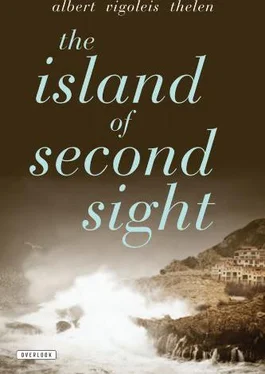“Cloudless days: over 170 per year; rainy days: no more than 70; fog: 4 or 5 days.” That’s what the travel brochures say, and I have altered nothing from personal experience, which like all appearances can be deceptive. There, in raw numbers, is the set of climatological preconditions for the miraculous merger of sky and earth whose charm at any given moment overshadows — if I may be allowed such a jarring reversal of metaphor — attractions that Nature normally takes centuries to bring forth elsewhere.
A trace of this magical illumination was also visible in the vestibule of the house occupied by the individual we were now visiting. I have chosen the word “individual” deliberately, with the pejorative connotations it carries with it. By calling her a “bitch,” Zwingli had already degraded — or perhaps upgraded — the character of his female companion to that of a mere “individual,” especially if we consider what he said about her bedtime talents. Presumably we would soon find out what kind of bitchery he actually was referring to. Was “bitch” a term of endearment? Or did it designate a common street sister? Did he mean to suggest a woman of slovenly habits? Should we already start turning up our noses?
As I have mentioned, there was a handful of that magical light in her apartment vestibule, and at one and the same time it put me in a mood of both reverence and suspicion. Why were the occupants of this house so parsimonious with the celestial gift of light? Wallpaper, which might be subject to fading, was nowhere to be seen. Instead the walls were whitewashed, a type of finish I associated with root cellars and livestock barns. But my very brief sojourn on this island had already taught me that my personal yardstick was ripe for the kindling pile. I would have to acclimate myself to new standards in the same way as I would have to get used to this odd indoors apportionment of daylight.
Was I bothered by the darkness, Zwingli inquired. Surely I wouldn’t want it any darker, he said, and if it got any brighter, we would truly be in for it. Had I never heard of flies? One inch more of sunlight and we could be eaten alive!
Flies! So that was it! The perennial plague of the sunny climes, a foretaste of which we had experienced on shipboard! Flies abhor the very darkness that engenders them in swarms. More than most other species, they are lovers of light, the joy of the sunlit world, the very embodiment of the ecstasy of creatureliness. With their cosmopolitan inclinations and their trillions of progeny, they constitute a fine symbol for a faith in the future that puts to shame those of us humans who are inclined to piety. And yet humans don’t like them, particularly when they appear en masse . But humans in numbers raised to this power don’t appeal to their fellow humans either, to judge from the waves of genocide that we have been witness to. Give us a single human being, and things can work out just fine. Give us a million, and we make the sign of the cross and plot their annihilation. Give us a single buzzing fly on a melancholy summer afternoon, alone with a book of poetry in our private study — who would think of harming it as it flits around a central point not unlike our own spiritual core, the point we can only postulate and never locate with certainty? But let flies appear in multiples, and the swatter will swat and the blood will spurt. Man is to his fellow man a demon. To the fly he is a snapping dog.
By banishing sunlight, the woman of this house had also banished insects. The window shutters with their fixed blinds, called persianas , let in only the tiniest sprinkles of daylight. Surely that had something to do also with love. As we all know, love shuns the light. Only red light matches its confused inner urges. It stimulates the biochemical processes required for it to find its way out of platonic abstraction back to passion — though little lamps are in reality rarely necessary. In this context I have always been puzzled by the fact that the lowest color on the solar spectrum was selected as the STOP signal in modern traffic. Otherwise, where red lights emit their alluring gleam, life goes on at its most hectic pace. But this matter is far more complex than simple optical semantics. It is an existential problem, one that Jean Paul Sartre might one day solve for us from the exalted precincts of Paris. Red can, of course, also signify “danger,” and thus I should be less eager to claim for the color an exclusively erotic meaning.
My eyes soon adjusted to the soft twilight that filled the room like the glow from the clerestory in a basilica. In this room there was much for the twilight to fill, for it was as good as empty. Because it probably wasn’t intended as a room for sitting in, it contained just a very few items of furniture. I have mentioned that it was a “vestibule,” though one might even contest this designation. There was a bench whose seat and back were made of loosely woven wicker or straw, a few chairs, a table with sideboard that resembled not so much a bonafide table as a South Sea Island catamaran, and two oversized wooden pedestals supporting artificial palms. That was all. These imitation plants, it must be said, produced more subtropical ambience than the decidedly fake-looking real palms to be seen in the conservatory of Amsterdam’s Hotel Krasnopolsky. With phony decorations it always comes down to what purpose they are meant to serve. I know certain people who right now are living out their waxen character so determinedly that no waxworks would ever dare to display the originals on a pedestal. The walls of this room in Palma also had a few paintings, but they were less effective as imitations. Not only did their tropical fruit fail to invite the viewer to take a bite. Even a mind untutored in art history could spot their insipid colors as indicative of cheap commercial reproductions. Suspended from the ceiling was a candelabra that looked like a ham in a butcher shop, especially as it was covered with a cloth sack.
One single fly buzzed around this mummified chandelier. It was evidently a degenerate specimen, for by rights it ought to have shunned the darkness, darted through a crack in the shutters, and joined the legions of its relatives that at this time of day were invading the meat stands over at the city market. Zwingli broke the silence by getting up and stretching. He gave a loud yawn, took off his jacket, and made himself comfortable. After all, he no longer had to treat us to the welcoming ceremonies at some princely hotel. And what about the ceremonies here in the Street of Solitude? To describe these I shall, for a moment, have to tell some history.
In the summer of the year 1601, Archduke Albrecht of Austria, the Spanish viceroy in the Netherlands, took up the siege of the city of Ostende. Isabella, who as daughter of Philip II of Spain had presented the Netherlands to her consort Albrecht as a dowry, vowed never to change her chemise until the city had surrendered to the Spanish army. Albrecht’s incentive to bring the siege to a rapid and victorious end was therefore very great, but the princess had underestimated the power of the Ostenders to hold out. The siege ended on the 20th of September, 1604 A.D., with a Spanish victory. Princess Isabella had thus worn her blouse for more than three years, offering proof of her patriotism and moral rectitude. There were solemn fanfares as she publicly dipped her blouse in a washtub. It turned the suds an inky color that today bears her name: a brownish-whitish-yellow tint like café-au-lait, known as “isabella.”
Surely no one will doubt the truth of this traditional account, insofar as the precise coloration is concerned. I myself regard the background circumstances also as authentic. Who might ever have profited from inventing such a story? Or perhaps “legend corrects history,” as Pascoaes says. I can only agree with him.
Читать дальше












